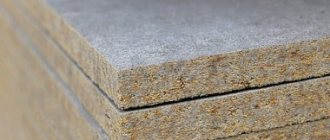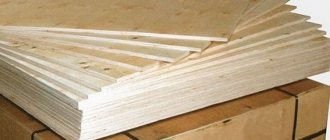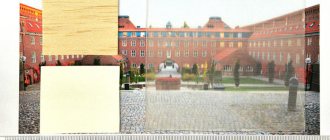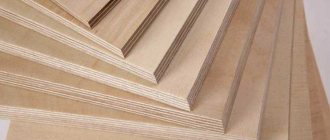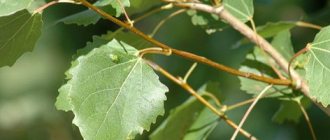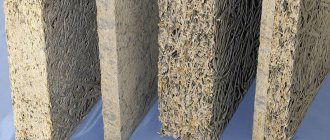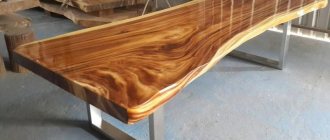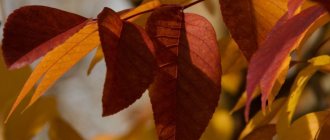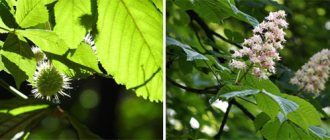Prices of oriented strand boards
The cost of OSB depends on several factors: group (moisture resistance), sample dimensions, thickness, manufacturer, region of sale (that is, transport surcharge).
The most popular boards are in the “moisture resistant” category (OSB-3). The approximate price for such a sheet is 2,500 x 1,250 (9) – 602.5. An analogue with a thickness of 12 will cost 719 rubles.
A slab 2,440 x 1,200 (9.5) costs 538. The price of the same 12 mm OSB is about 676.
Examples for individual slab manufacturers are summarized in the table.
It is advisable to purchase products from well-known, reputable companies. If their interpretation (as noted above) of OSB dimensions is quite arbitrary, then the requirements for tolerances (various deviations of parameters) are as “strict” as possible.
This means that the discrepancy from the declared dimensions is minimal. Consequently, during the installation of the slabs there will be no problems with their joining, significant gaps formed, and so on. Even if such products cost a little more, you won’t have to waste time and money (for example, on sealants or mastics).
Most people who decide to buy their own home or renovate their apartment, one way or another, are faced with the problem of choosing a relatively inexpensive and at the same time high-quality material intended for cladding the walls of a room or for building a frame country house in a short time.
In today's building materials market, a type of coating such as OSB boards is gaining increasing popularity. Their size allows you to cover a significant area with an even layer, without having to spend a lot of money. External finishing on the slabs is completed almost immediately.
Useful tips
Slabs up to 16 mm thick are used for finishing walls, as a base for soft roofing, and also for covering floors.
Recommendations for finishing walls and floors with OSB sheets
Sheets with a thickness of more than 16 mm can be used under significant loads. Floors are laid on such material, and load-bearing roof structures are also produced. For processing OSB, tools with carbide nozzles, cutters, saws and drills are used.
There are certain features when working with such material:
- the feed speed will be lower than when processing wood;
- It is better to secure the material with spiral or ring nails; it is better not to use others;
- when installing OSB in load-bearing elements, you need to select a material that will not rust;
- When installing slabs, it is necessary to leave gaps for insurance.
OSB boards are used for the construction of the entire structure
Materials such as OSB sheets make it easier to carry out any construction work. Thickness and dimensions, prices are selected depending on the planned work. It is worth considering that the installation of slabs is not done without prior preparation. When installing floor coverings, logs are installed. To install the roof using OSB, a special sheathing is created. When covering walls, a frame is required, for which profiles are used.
Using OSB boards correctly can greatly facilitate construction work. This material has higher quality indicators than many alternative options.
Features of installation of the rough foundation
So, if you decide to use OSB boards for subfloor equipment, you need to decide what you will lay them on: concrete or wooden joists. In any case, the most acceptable material will be OSB - 3. If the base for installation is a concrete screed, then the thickness of the sheet may not exceed 1 cm. In the case of laying on wooden logs, this parameter can reach a maximum of 2.5 cm. The material is attached to concrete at using dowels. You can fix it on the tree using self-tapping screws. Please note that the fastener heads must be recessed into the slab. This way you will achieve a perfectly even surface. If you need to achieve maximum strength of the base, then the sheets should be laid in 2 layers. In this case, the seams in the lower and upper layers should not match.
During installation, pay attention to the quality of the joints. They need to be leveled and smoothed as much as possible.
For this, an elastic sealant is used. The arrangement of the subfloor is done as follows:
- To begin with, logs are installed on the floor.
- Now you can screw additional bars to them (at the bottom). Their cross section should be 5x5 cm.
- The side that will be in contact with the concrete or facing the ground must be additionally treated with an antiseptic or bitumen mastic (one layer is enough).
- Fastening plates. This can be done using special nails, screws or glue.
- . This can be polystyrene foam or mineral wool. Expanded clay can also be poured between the slab and the ground.
- Laying an additional OSB board, which will serve as the basis for subsequent cladding.
The material can also be laid on a dry screed. The filling must first be leveled along the beacons. Next, it is necessary to install a layer of OSB, on top of which the same sheets are laid, only with the seams shifted. They can be fixed using self-tapping screws, the pitch between which is 15 cm. Please note that the fasteners must be screwed along the edge of the second layer.
Many owners of suburban areas, apartments and individual houses are interested in inexpensive and high-quality material suitable for renovating a room, cladding a building, or building a frame country house in the shortest possible time.
Currently, a relatively new type of coating has become quite popular - OSB board, the dimensions of which allow you to cover a fairly large area with an even layer without any special costs and immediately carry out external finishing on it (for more information about OSB finishing, see and).
Updating the façade of a building with OSB panels
The breadth of application of the panels, regardless of the size of the OSB, is amazingly diverse. At the same time, the same OSB board cannot change its application characteristics. It is either intended for exterior decoration or not, it is either strong enough for a roof, or it simply will not withstand the pressure.
However, OSB board of “standard” sizes is perfect both for cladding and for forming the basis for construction. Paradoxically, there are examples of buildings constructed entirely of OSB. In this case, the panels act as a base for expanded polystyrene, resulting in a sufficient heat-saving effect.
This combination is known as a sandwich panel. Usually they have an OSB sheet size of 9mm, and polystyrene foam sheets are taken according to the standard. Using sandwich panels, you can quickly, following the example of a designer, form a medium-sized building.
As for the exterior finishing, in this case the dimensions of the 9 mm OSB board are not required, and polystyrene foam is not needed at all. The essence of the process comes down to attaching OSB sheets to the facade for insulation and at the same time solving design problems.
Below we will consider the standard sequence of actions for framing a building with oriented strand boards. Let us remind you once again that the size of OSB is selected here completely individually.
Stage one. Lathing.
A vertical frame is created from beams, covered horizontally with mineral wool.
Stage two. Belt fastening.
It is necessary to level the walls by installing special racks on which the sheathing will subsequently be attached.
Stage three. Control of vertical and horizontal lines.
The parameters of the “grid” formed by the posts and beams depend on the dimensions of the OSB board. In accordance with them, the distance between the wooden posts is determined, and then between the perpendicular horizontal beams.
If the OSB board has non-standard dimensions, you will have to think about the laying format in advance. And in order to maintain the same level, it is recommended to stretch a nylon thread between the outer posts and adjust the posts located in the middle to it.
Stage four. Insulation and counter-lattice.
This step is not necessary, but will serve for better thermal insulation. The beams are positioned perpendicular to the first layer of the sheathing, with insulation material located between the layers.
When the dimensions of the OSB sheet are too large or the panel does not have an edge along the profile, it is recommended to install special jumpers where the seam (joint) is located.
Stage five. Waterproofing.
A film is laid between the insulation and the next layer of counter-lattice and attached to the panels
Again, pay attention to the OSB size, since it is better to immediately prepare the film to cover 2 or more sheets
Stage six. OSB sheathing.
The edges of the sheets are attached exactly to the middle of the belts. Each sheet is screwed to the beam using a self-tapping screw.
Stage seven. Finishing.
The seams are sealed, the surface is varnished and painted. Outside, you can install an additional layer of decorative oriented strand boards. Moreover, for OSB, the dimensions of the sheet in this case may not correspond to the dimensions of the OSB sheets of the inner layer.
Properties and technical specifications
OSB boards compete with other sheet materials both in the field of construction (for covering frames, creating formwork) and in the field of finishing (leveling walls, floors, ceilings). This is facilitated by the properties of OSB:
- The strength is approximately the same as that of plywood and 2.5 times higher than that of chipboard.
- High degree of moisture resistance. According to standards, water absorption when in water during the day is no more than 10%.
- OSB boards can be sawed and drilled with standard carpentry tools.
- Can be fastened with screws or self-tapping screws. Fasteners are held better than in coniferous plywood and chipboard.
- Not damaged by rodents and beetles.
- With normal quality, voids, delaminations and other defects are rare.
Once again, please note that moisture resistance and resistance to deformation are characteristic of OSB, which was made in compliance with the technology. Unfortunately, Russian-made material is not of high quality
Less powerful presses are used, they try to save on binders, and do not apply markings. As a result, there are many examples of negative experiences: slabs swell from moisture, they warp, the glue is washed out... The solution is to look for slabs made imported (Europe or the USA). Due to the rise of the dollar, they now have considerable prices; there are very few of them on the market, but, if desired, you can find them or order them for delivery.
Comparison of characteristics of sheet building materials
The situation is aggravated by the fact that it is impossible to distinguish moisture-resistant OSB3 from non-moisture-resistant OSB2 or 1 by appearance. The latter cost much less. Unscrupulous sellers sell cheaper ones under the guise of being moisture resistant. This is where trouble starts. As a way out, you can do this: buy one sheet of OSB 3, check its behavior at high humidity. If there are no visible changes, buy a batch.
Geography of production as an indicator of quality
Despite the fairly affordable technology, there are only a few largest manufacturers of OSB boards in the world. The main production facilities are located near large wood processing enterprises: Kronospan (Austria), Norbord (Belgium), Louisiana Pacific (USA), Glunz, Ainsworth (Germany).
A number of large production facilities have been built in China, but the value of raw materials is low, much lower than that of products from the EU countries, the USA and Canada. In addition to using more toxic resins, poplar shavings are used. It is significantly inferior in terms of strength compared to coniferous wood.
In Russia, the first production was launched in 2012 in the city of Kirov, in the Vladimir region (Hilman), the Kalevala DOK is operating, and the Kronospan plant is expected to be put into operation in the Moscow region. Today, there is production of OSB-3 and OSB-4 in the city of Torzhok, and projects have also been announced in Komi, Bashkiria, the Pskov region and Siberia.
The quality of the slabs directly depends on the supplier, the cost - on the region of delivery. Russia is characterized by the deployment of new production lines and the use of softwood shavings. Chinese OSB is not in demand due to unstable parameters. The most popular brand is Kronospan, which guarantees stable quality and environmental safety. Due to its features, OSB is one of the best materials for facade cladding, but if its quality is not guaranteed, it is not recommended for use in interior design.
We recommend checking out - Find the perfect color scheme for your kitchen
Installation of OSB on the roof
OSB-3 boards, the technical characteristics of which allow them to be used for external work, should be fastened only after checking the evenness and strength of the rafter legs or joists of the sheathing system. If the mentioned elements are not installed level enough, this will affect the appearance of the roof. If the canvas gets wet in the rain, it is not recommended to use it until it dries. When installing above an attic or any other space that is not heated in the winter, you should be concerned about ventilation. The holes for this should not be less than 1/150 of the entire horizontal base.
Taking into account the structure of the canvas, it must be fastened with a long edge at a right angle to the rafter leg or sheathing elements. The junction of the short edges of the sheet should be on the roof supports. As for the long edges, they also need to be secured or stapled where necessary. It is worth creating a gap between the material with straight edges, the minimum width of which is 3 mm: this will prevent deformation during expansion. The slab must be laid on at least two supports.
Floor slabs: product features and material use
OSB flooring board is a popular finishing building material, for the production of which waste from the woodworking industry is used:
- wood chips obtained from processing aspen trunks;
- shavings formed when sawing coniferous trees.
The composition of the slabs, along with chips, includes the following materials:
- wax filler obtained as a result of a synthetic reaction;
- moisture-resistant resins based on phenol and formaldehyde components.
The minimum size of wood chip filler is 60 mm, and the maximum is 90 mm.
OSB (oriented strand board) is a material successfully used in construction and furniture manufacturing
When making panels, wood chips are laid in several layers, each of which differs in the orientation of the wood fragments:
- The outer layers of the product are characterized by a longitudinal arrangement of fragments of wood shavings;
- A distinctive feature of the internal layers is the transverse placement of the chip fraction.
The production of plates is carried out under conditions of elevated temperature and also at high pressure. Chips impregnated with moisture-resistant resins are pressed using special equipment. The result is a slab having the required dimensions. The material's strength characteristics are superior to chipboards and plywood sheets. Increased flexibility of the panels is achieved due to the mutually perpendicular orientation of the wood chips. Modern manufacturing technology, laboratory control and reliable equipment guarantee the quality of the floor slabs.
The thickness of the material, which has an increased safety margin, allows you to form a reliable basis for finishing the floor with the following coatings:
- ceramic tiles;
- parquet boards;
- carpet;
- various types of linoleum;
- moisture resistant laminate.
OSB slabs for flooring are a type of finishing building material, which is characterized by a regular rectangular shape. The panels have fixed dimensions and are also characterized by the absence of cracks and local defects.
OSB differs in the thickness and grade of the material, depending on the size of the raw materials, density and quality of the resins used, which affect moisture resistanceOriented strand panels solve a range of problems:
- form a flat surface of the floor base mounted on wooden beams;
- compensate for differences in height of reinforced concrete and wooden bases for laying finishing;
- create a comfortable temperature in living spaces by laying thermal insulation between the sheets and the base surface;
- prevent street noise from entering the room due to the multilayer structure of the material;
- reliably isolated from the penetration of moisture entering through the capillary channels of the concrete mass.
The area of use of the material differs for different types of products:
- OSB-1 boards, characterized by a low price, have increased hygroscopicity and insufficiently high strength. They are intended for use as a finishing material. Sheet cladding is used in rooms with low moisture concentration;
- OSB-2 panels have an increased safety margin and are less hygroscopic than OSB-1 boards. The products are able to withstand increased loads and are used for interior cladding of floors, walls and ceilings in dry rooms, as well as in the production of furniture;
- OSB-3 brand products are designed for use in high humidity environments and have high strength characteristics. Panels marked OSB-3 are used for finishing activities carried out indoors and outdoors;
- Products marked OSB-4 have proven themselves in structures that can withstand increased loads. OSB-4 boards are used if protection of the external surface of loaded structures is necessary. The panels are characterized by increased moisture resistance and maximum strength.
For flooring, manufacturers produce slabs with a tongue-and-groove edge, which ensure a tighter fit of the slabs to each other
When deciding which sheets should be used to finish the floor, you should study the performance characteristics of the slabs, as well as take into account specific operating conditions. Experts recommend using class three (OSB-3) products to form the floor surface, which maintain integrity when exposed to forces from furniture, equipment, interior items and moving people.
How should the material be treated for different types of flooring?
OSB floors can be rough or finished. In the second case, the surface is simply sanded and varnished. Naturally, the gaps between the sheets should be invisible. If you decide to lay another facing material on top of OSB, then the base must be pre-prepared depending on what kind of coating you will use:
- . The base must be level, especially at the junctions of the slabs.
- or . In this case, it is better to use thin slabs, which will make the transition between them smooth and almost imperceptible. Additionally, it is treated with a sealing agent. Please note that if one sheet of OSB is laid on the floor, then the compensation gap is arranged on the side of the walls.
- . When choosing such a facing material, it is necessary to take into account that the base for its installation should be as strong and level as possible. Sheets should be secured so that they are motionless. If you are laying OSB on logs, then in this case they should be mounted at a short distance from each other.
Classification of OSB sheets by edge and surface type
In addition to purely technical parameters, OSB sheets differ from each other in physical as well as aesthetic features. The appearance, as well as the surface characteristics of the sheets, determine how well they will fit into the interior or match the design style of the building.
So, let's look at what OSB boards can be like in terms of their surface.
Unsanded
A simplified version, virtually devoid of processing. The surface in this case remains rough, rough, and there may be protruding parts of wood chips.
The main advantage of such sheets is their low cost. In addition, unpolished slabs adhere well to other materials and do not slip.
The main direction of use is for roofing as sheathing.
Sanded
As the name implies, this is an option when the surface of the sheet is well cleaned and processed. In this case, it is easy to coat the slabs with paint or varnish and place one on top of the other.
Due to the processing that took place, the cost of the products increases compared to unpolished slabs.
Varnished
These are the same sanded sheets that have already been varnished in advance using a special roller machine. This pre-treatment makes the panel resistant to moisture, gives additional strength and a more attractive appearance.
Accordingly, the area of application of varnished OSB is mainly related to design and decoration.
Laminated
The most modern and expensive option.
In this case, the surface of the OSB sheet is coated not just with varnish, but with a special polymer material. This gives maximum strength and creates a very beautiful, expensive image.
The mined surface can be decorated in almost any color or even several shades.
Main characteristics of OSB boards
The popularity of OSB boards in Russia is only gaining momentum. In Europe and especially North America, this material has long been in steadily growing demand due to its unique properties:
- Convenient sizes. OSB boards are supplied to our country, the sizes of which are ideal for a wide variety of applications. For example, when building frame houses, one standard sheet of 1.22 x 2.44 m can cover two spans of racks, forming 56 cm wide cells between them, which are perfect for filling with modern insulating materials.
- Ease of processing. OSB products are easily sawed with all types of modern electric or manual tools, forming an even cut without chips or cracks at the cutting site. The thickness of OSB boards does not exceed the maximum processing depth with household electric saws.
- Strength and rigidity. Oriented strand boards can withstand heavy loads and hold all types of fastening elements (screws, nails, screws, etc.) well. In this indicator, they are practically not inferior to solid boards, so they are easy to connect with each other and with various elements of building structures.
- Absolutely flat surface. No additional processing is required; the installed slab can be immediately painted or finished with facing materials.
- Attractive price. OSB is one of the cheapest building materials. The cost per square meter of popular brands of slabs of the third category is about 150 rubles.
- Small mass. The weight of a 9 mm OSB sheet is about 18 kg, so it is easy to transport and lift to the required height (for example, when installing a roofing underlay).
OSB board sizes
The standard dimensions of OSB sheets are: 1250×2500 mm. according to European standards and 1220x2440 mm. by North American standards. Sometimes you can find slabs 3000 and 3150 mm long on sale. Some manufacturers, upon request, produce longer slabs, up to 7 meters.
We advise you to study - Density of expanded clay - what it is and what it depends on
When choosing the size of OSB boards, it is best to give preference to larger sheets. By choosing larger sheets, you will get fewer joints after installation
This is very important when covering some structures. An example is the cladding of the walls of a frame house.
In this case, it is very important that one slab covers the entire height, from the bottom to the top floor or roof.
The thickness of OSB sheets varies from 6 to 25 mm. The choice of thickness depends on the following factors:
- OSB grades;
- expected loads;
- distances between supports.
Dimensions, weight and area of OSB sheets from popular manufacturers
On the domestic market, strand boards are represented by products of Russian and European companies, among which the most recognizable brands are: Kronospan (Belarus, Mogilev), DOK Kalevala (RF, Karelia), GLUNZ (Germany), EGGER (Romania) and Ultralam (Germany). Torzhok, Russian Federation).
Kronospan
Kronospan is an Austrian manufacturer of wood materials with an extensive network of factories around the world, including Belarus. The OSB of the Mogilev enterprise meets European standards, but at the same time has an affordable price. Excellent performance characteristics and increased moisture resistance have made OSB of the Kronospan brand one of the leaders in sales of the Russian building materials market.
| Brand | Sheet dimensions, mm | Sheet area m2 | Sheet weight, kg |
| OSB-3 | 2500×1250×9 | 3.1 | 17.2 |
| 2500×1250×10 | 19.1 | ||
| 2500×1250×12 | 22.9 | ||
| 2800×1250×12 | 3.5 | 25.6 | |
| 2500×1250×15 | 3.1 | 28.6 | |
| 2500×1250×18 | 34.3 | ||
| 2500×1250×22 | 41.9 | ||
| OSB-4 | 2440×1220×11 | 3 | 20.15 |
| 2500×1250×12 | 3.1 | 23.5 | |
| 2500×1250×15 | 29.4 |
DOK Kalevala is the largest manufacturer of wood-based panels in Russia. The company has introduced the latest technologies, which has allowed it to produce high-quality and environmentally friendly products that meet the highest safety standards. Thanks to these features, OSB from DOK Kalevala has gained popularity not only in the Russian Federation, but also in the CIS countries.
| Brand | Sheet dimensions, mm | Sheet area m2 | Sheet weight, kg |
| OSB-3 | 2500×1250×8 | 3,1 | 15,5 |
| 2440×1220×9 | 3 | 16,6 | |
| 2500×1250×9 | 3,1 | 17,5 | |
| 2440×1220×12 | 3 | 22,2 | |
| 2500×1200×12 | 22,3 | ||
| 2500×1250×12 | 3,1 | 23,3 | |
| 2800×1250×12 | 3,5 | 26,1 | |
| 2500×1250×15 | 3,1 | 29,1 | |
| 2500×1250×18 | 34,9 | ||
| 2500×1250×22 | 42,6 | ||
| 2440×1220×22 | 3 | 42 | |
| OSB-3 with 2-sided tongue and groove. | 2500×1250×12 | 3,1 | 23,3 |
| 1250×1250×12 | 1.6 | 11.7 | |
| OSB-3 with 4-sided tongue and groove. | 2500×1250×12 | 3,1 | 23,3 |
| OSB-3 Ecohouse | 2500×1250×9 | 17,5 | |
| 2500×1250×12 | 23,3 | ||
| 2800×1250×12 | 3,5 | 26,1 | |
| OSB-3 Ecohouse with 2-sided tongue and groove. | 2500×1250×12 | 3,1 | 23,3 |
| OSB-3 Ecohouse with 4-sided tongue and groove. | 2500×1250×12 |
GLUNZ
The German brand GLUNZ is rightfully considered the flagship of the strand board industry. A special feature of the manufacturer is the use of high-quality timber and environmentally friendly adhesives. The company produces OSB-3 with a formaldehyde emission level of E0. This makes GLUNZ OSB absolutely safe.
| Brand | Sheet dimensions, mm | Sheet area m2 | Sheet weight, kg |
| OSB-3 | 2500×1250×6 | 3.1 | 12.2 |
| 2500×1250×9 | 18.3 | ||
| 2800×1250×9 | 3.5 | 21.9 | |
| 2500×1250×12 | 3.1 | 24 | |
| 2800×1250×12 | 3.5 | 28.8 | |
| 2500×1250×15 | 3.1 | 36 | |
| 2500×1250×18 | 54 | ||
| 2500×1250×22 | 24 | ||
| OSB-4 | 2500×1250×9 | 12.2 | |
| 2500×1250×12 | 24 | ||
| 2800×1250×12 | 3.5 | 28.8 | |
| 2500×1250×15 | 3.1 | 36 | |
| 2500×1250×18 | |||
| 2500×1250×22 | 24 | ||
| OSB-3, tongue and groove | 2800×675×12 | 1.9 | 13 |
| 2500×675×15 | 1.7 | 16.2 | |
| 2500×675×18 | |||
| 2500×675×22 | 23.8 |
EGGER
A European brand whose products are considered the standard of high quality at an unusually low price. OSB of this brand, produced by a Romanian company, has good density, ideal geometry and low hygroscopicity, which makes them indispensable in construction and furniture production. The manufacturer produces slabs of environmental standards E1 and E0.
| Brand | Sheet dimensions, mm | Sheet area m2 | Sheet weight, kg |
| OSB-3 | 2500×1250×6 | 3.1 | 12 |
| 2500×1250×8 | 16 | ||
| 2500×1250×9 | 17.4 | ||
| 2500×1250×12 | 23.3 | ||
| 2500×1250×12 | 3.5 | 26 | |
| 2500×1250×15 | 3.1 | 28.1 | |
| 2500×1250×18 | 32.8 | ||
| 2500×1250×22 | 42.8 |
Mechanical properties according to EN 300 standard
| Characteristics | Test method | Plate thickness, mm | OSB-1 | OSB-2 | OSB-3 | OSB-4 |
| Bending strength – major axis, N/mm2 | EN 310 | from 6 to 10 | 20 | 22 | 22 | 30 |
| > 10 and < 18 | 18 | 20 | 20 | 28 | ||
| 18 to 25 | 16 | 18 | 18 | 26 | ||
| Bending strength – lateral axis, N/mm2 | EN 310 | from 6 to 10 | 10 | 11 | 11 | 16 |
| > 10 and < 18 | 9 | 10 | 10 | 15 | ||
| 18 to 25 | 8 | 9 | 9 | 14 | ||
| Modulus of elasticity – main axis, N/mm2 | EN 310 | from 6 to 10 | 2500 | 3500 | 3500 | 4800 |
| > 10 and < 18 | ||||||
| 18 to 25 | ||||||
| Modulus of elasticity – lateral axis, N/mm2 | EN 310 | from 6 to 10 | 1200 | 1400 | 1400 | 1900 |
| > 10 and < 18 | ||||||
| 18 to 25 | ||||||
| Tensile strength perpendicular to the plane of the slab, N/mm2 | EN 319 | from 6 to 10 | 0,30 | 0,34 | 0,34 | 0,50 |
| > 10 and < 18 | 0,28 | 0,32 | 0,32 | 0,45 | ||
| 18 to 25 | 0,26 | 0,30 | 0,30 | 0,40 |
Health hazards of OSB boards
Each slab of shavings contains another not very useful, or rather completely harmful, component. It is the glue that connects the entire OSB structure into a single whole - formaldehyde. However, when bound, it is absolutely safe, but there is one point that destroys this myth. During the manufacture of the board, it contracts, so the structure of the glue collapses and when the sheet is used, a certain level of toxins is released into the room. The toxicity class is designated as follows: - E0.5 - formaldehyde emission of no more than 0.08 mg/m³ of air; — E1 – formaldehyde emission from 0.08 to 0.124 mg/m³ air; — E2 – formaldehyde emission from 0.124 to 1.25 mg/m³ of air.
For installation of OSB boards indoors, it is better to use boards with toxicity classes E0.5 and E1. Such slabs are as harmless to health as other building materials.
Features of use
Due to their practicality and excellent physical and technical parameters, oriented strand boards are used in various industries, including construction, furniture manufacturing, etc. At the same time, to the question: “OSB board, what is it?” we can answer that it is an easy-to-use, universal material that can be used both as an independent coating and as an auxiliary element for preparing the bases of various types of coatings for finishing.
It is well suited for interior cladding of various premises, including balconies and loggias. In this case, the technical characteristics of the OSB 3 board best allow it to serve as a base for laying various types of floor coverings, including tiles, laminate, linoleum and parquet boards. In this case, the sheets are laid on wooden blocks, after which the working surface is finally leveled using a concrete screed (rarely used) or the finishing coating is immediately mounted on the sheets.
To ensure better strength and durability of the base under the floor covering made of OSB boards, you can use two layers of sheets, laying them offset, securing them together with adhesive and spiral and ring-type nails. When installing, be sure to leave small gaps between the plates to prevent their deformation during natural expansion during use.
The use of OSB boards on the balcony with different types of finishing has its own characteristics. For example:
Installation of OSB flooring on the balcony
- When installing oriented strand boards under laminate, it is necessary to ensure the evenness of the surface at the joints of its sheets.
- When laying under linoleum or carpet at the joints of the material, to ensure maximum evenness, you need to use sheets of minimal thickness, and treat the gaps with sealants.
- When used as a stand-alone floor covering. Additional protection of the material from abrasion and wear is needed. To do this, after preliminary cleaning, it is coated with several layers of varnish.
- Under ceramic tiles. The base of OSB boards must be completely motionless. Therefore, the sheets should be secured especially carefully, and the logs under them should be installed in smaller increments.
When constructing a subfloor from OSB slabs, the sheets are initially installed on the underside of the joists. Wherein:
- The side of the slab facing the ground is treated with bitumen mastic.
- Insulation is placed in the space between the joists, which must be covered with a layer of waterproofing material (for example, glassine).
- Another OSB board is attached to the top.
An example of installing an OSB board on logs is shown in the video.
Installation OSB floor on wooden joists
Watch this video on YouTube
How much does an OSB sheet cost in Leroy Merlin - sizes and prices
On the Leroy Merlin website, OSB boards are presented in 10 options. Almost all of them are considered moisture resistant. Next to each product name the cost is indicated separately for the product and per sq.m. Prices per square meter on the website range from 142 to 513 rubles. For one slab, depending on its parameters and thickness, you will need to pay from 300 to 1415 rubles.
OSB board 6 mm
A slab of this format is represented by the Ultralam brand. Product parameters: 1250 by 2500 mm. The weight of the product is 11 kg, the cost of one slab is 472 rubles, sq. m. will cost 151 rubles.
This option is suitable for leveling walls and floors (before laying laminate or parquet), and is used as a base for arranging a roof. It is easy to process, moisture resistant, and is not damaged by insects.
OSB 9 mm
The parameters of 9 mm OSB sheets, which are offered in Leroy Merlin, are 625 by 2500 mm. The cost of one slab is 324 rubles, 1 sq. m. will cost 207.29 rubles. The weight of the plate is almost 9 kg. Brand – Ultralam. Building materials are produced in Russia.
OSB board 12 mm
OSB boards with a thickness of 12 mm are not currently available in Leroy Merlin, but you can choose an option with a thickness of 11 mm. Weight – 23 kg, cost – 631 rubles. Per sq.m. you need to pay 201.92 rubles. Sheet parameters – 1250 by 2500 mm.
Can be used as a roofing material, for leveling a floor or as a device for constructing a subfloor.
OSB-3 18 mm
OSB boards with such parameters in Leroy Merlin are represented by the Ultralam brand. The dimensions of one slab are 1250 by 2500 mm. Package weight – 35 kg, cost of one slab – 990 rubles, 1 sq.m. will cost 315 rubles. Typically, this option is used when leveling walls, as a base when laying a roof made of ordinary tiles or metal. This option will also be relevant when laying laminate, parquet or tile floors.
The same version of OSB board is presented in the store with tongue-and-groove edges. Sheet parameters – 610 by 2485 mm.
Both options (OSB 3) have the following advantages:
- The material is moisture resistant. During research it was proven that such a plate can be kept in water or a humid environment for 24 hours and retain its characteristics.
- It is easy to process. It is easy to drill, cut and join using different types of glue.
- The sheets are easy to install due to their low weight.
- OSB-3 is not susceptible to damage by insects.
- They have a high fastener retention rate.
- The material is distinguished by its strength and workmanship - there are no surface defects or they are minimal.
- Variations in board thickness do not exceed 0.3 mm.
The material will need protection if it is constantly exposed to ultraviolet radiation.
Moisture-resistant OSB board
Of all the options for OSB boards that are offered in Leroy Merlin, the following are considered moisture resistant:
OSB 3 board with a thickness of 8 mm and parameters of 1250 by 2500 mm.
OSB 3 board from Ultralam, 11 mm thick.
OSB board 3 Ultralam 6 mm.
OSB board Ultralam 15 mm (both the regular version and with tongue and groove).
OSB board of Ultralam brand 18 mm (regular version and with tongue and groove).
OSB board of Ultralam brand 22 mm (regular version and with tongue and groove).
These types of slabs are ideal for finishing surfaces that are exposed to high humidity.
OSB 3 structure
Modern OSB (OSB or Orient Strand Board) is a structural building material made of wood (usually pine, rarely aspen). It is based on large-sized chips bonded with waterproof resin under pressure and temperature.
OSB 3 sheet in section - its constituent layers are visible
The main difference between this material (especially when compared with the once popular Soviet chipboard) is the orientation of the chips. In the outer layers it is located longitudinally, in the inner layers – transversely. Usually there are three layers, less often – four.
OSB (in Russian it is increasingly “called” OSB, which means oriented strand board, which corresponds to the English name) is made from wood chips 7.5 - 15 cm long and 1-1.2 cm wide with a thickness of 0.5 -0.8 mm. The smaller fractions obtained during production are used to produce another type of slab - chipboard, or burned.
We advise you to study - How to make an insulated doghouse with your own hands
Choosing OSB sheets: thickness and dimensions, prices
Having decided for what purposes the slabs will be used, you can proceed to choosing the thickness and size of OSB sheets. The price will depend not only on these indicators, but also on the chosen manufacturer. Today, the price for an OSB 3 sheet with a size of 2440x1200x9 mm ranges from 500-650 rubles per piece. The cost of a thicker sheet is higher, and the price of an OSB board measuring 1250x2500x18 mm will be about 1000 rubles per piece.
OSB has high reliability, confirmed in construction and repair practice.
Therefore, you should not purchase slabs of a higher class than necessary. This will lead to financial costs that are not necessary. It is better to take OSB plywood that is suitable in size, price and sheet thickness, recommended for this type of work from a more well-known manufacturer.
Creative interior solution using OSB
Having familiarized yourself with the proposed range of sizes and prices of OSB boards, you will be convinced that this is an inexpensive and versatile building material that allows you to easily perform a lot of different jobs. And with all this, such sheets are safe for the environment and your health.
Specifications and Use
Scope of application of OSB boards
OSB boards are used in the following areas:
- Frame type construction;
- When covering walls, roofs, ceilings;
- As a subfloor;
- As a decorative element of wall upholstery;
- When erecting billboards and making frames;
- As a primary substitute for lumber;
- As shelves and racks;
- In the production of boxes and packaging;
- As a variety of formwork.
A very important criterion for dividing OSB boards is thickness. This characteristic is of great importance. The standard length and width remain 2500 x 1250 mm. But the thickness ranges from 8 to 26 millimeters.
If it is used for cladding and there is no significant load on it, then thin sheets up to 16 millimeters can be used. They can be used to build walls, sheathe floors, etc.
This mainly happens when it is necessary to make a base for installing heavy equipment. This material perfectly combines the quality characteristics that are characteristic of wood. The technology of use is very convenient, which is typical of elite materials. OSB excellently retains its consumer qualities and in an aesthetic sense.
It has a beautiful structure and color of whole wood. OSB boards perfectly comply with modern requirements that apply to this type of material. These slabs are perfect for the construction of attics. In North America, OSB is used as a structural basis for all cottage construction. These play the role of a frame. The use of this material is almost completely waste-free.
In construction, it is very important to follow the basic rules for protecting wood. In order to ensure long service life and reliability of the materials used, it is necessary to analyze all structures at the time of diffusion, condensation of water vapor
OSB can withstand significant loads, so it can easily be used as the basis for asphalt shingles or copper roofing. The availability and versatility of this material makes it very popular. And are you still thinking about which material to choose?
Prices for OSB boards vary, let's give an example. OSB 3 board, size 2.5*1.25, 9mm, 12mm, moisture resistant, made in Latvia – 520 rubles
Types of edges of OSB sheets
In this case, there are only two types - straight edge and figured edge.
Direct is used as a base, rough material, base for further finishing. Sometimes a straight edge is used for the production of containers, boxes, etc. from OSB.
As for the curly edge, it is suitable for the final final cladding. It provides that the sheet will have grooves and bulges on different sides, due to which the most tight joining is possible. Accordingly, it will be possible to assemble a homogeneous plane from several sheets while maintaining maximum heat and moisture insulation.
Production of moisture-resistant panels
OSB translated from English (Oriented Strand Board) is a board with increased moisture resistance. This material, consisting of three layers of coniferous wood chips, oriented longitudinally in the outer layers and transversely in the inner layers, is easy to process, does not crumble and holds fasteners well.
Moisture-resistant OSB panels are made by pressing and gluing long wood chips. The inner and outer layers are located perpendicular to each other, and there can be 3-4 such layers. The surface of the plate is always smooth. It is superior in strength to chipboard and MDF, but is close to plywood in its mechanical and physical properties. The products are relatively easy to sand.
It is advisable to use OSB with a thickness of 3. only in strict accordance with their intended purpose. Swapping is not recommended. A slab intended for an external wall cannot be installed from the inside. Since harmful substances can be released into the room and harm your health.
Where are OSB-3 panels used?
- wall cladding;
- roof sheathing - for concrete tiles, metal tiles, slate;
- subfloors and single-layer floors;
- partitions, decorative wall cladding;
- I-beams or I-beams;
- removable reusable formwork for concrete work;
- production of packaging - boxes, containers.
How to choose quality products
Panels of varying quality are available on the construction market. You should choose products and manufacturers very carefully. Order moisture-resistant OSB boards in our online store. Please check with managers for sizes. The goods can be picked up or ordered delivered.
What properties should a quality product have:
- When sawing, the slab does not crumble, deteriorate or break.
- In addition, they do not warp when wet and dry.
- The nail or screw fits easily into the OSB.
- It can be sanded, varnished, painted, laminated, tinted.
There are no delaminations, knots or other mechanical damage in the thickness of the OSB, leading to a decrease in the quality of the finished product. Elasticity and strength are significantly higher than that of solid wood. Increased moisture resistance, resistance to rotting and fungi. Standard OSB boards do not have cavities, knots and other similar defects that can be observed with other wood panels.
When producing OSB panels, their ends are treated with moisture-resistant sealants. This significantly extends their shelf life on the construction site. In addition, the sheets are less susceptible to drying out than plywood and have a better combination of cost and quality. Contractors are increasingly buying this particular one for roofing work. Markings are applied to the surface of the sheets. The thickness of OSB is usually 6 - 18 millimeters. But, if the customer needs a sheet of other size and thickness parameters, then producing it will not be a big problem.The OSB edge can be either smooth or milled, with grooves and ridges for connecting adjacent boards. When covering the floor, OSB is used, milled on both sides. If a house is being built using frame technology, then they are used for external and internal cladding. The rest of the space between the sheets is filled with insulation.
size table
Which OSB is best to choose for finishing is up to you to decide!
What is OSB? This is an oriented strand board, abbreviated as OSB, that is, in English, oriented strand board. This building material consists of several (at least three to four) layers of wood chips of various sizes, from the smallest to thin chips. The shavings in each layer are pressed and glued, but the main difference from similar materials is that they are laid in a certain direction. Usually this is longitudinal for the outer layers, and transverse for the inner ones.
Updating the façade of a building with OSB panels
The breadth of application of the panels, regardless of the size of the OSB, is amazingly diverse. At the same time, the same OSB board cannot change its application characteristics. It is either intended for exterior decoration or not, it is either strong enough for a roof, or it simply will not withstand the pressure.
However, OSB board of “standard” sizes is perfect both for cladding and for forming the basis for construction. Paradoxically, there are examples of buildings constructed entirely of OSB. In this case, the panels act as a base for expanded polystyrene, resulting in a sufficient heat-saving effect.
This combination is known as a sandwich panel. Usually they have an OSB sheet size of 9mm, and polystyrene foam sheets are taken according to the standard. Using sandwich panels, you can quickly, following the example of a designer, form a medium-sized building.
As for the exterior finishing, in this case the dimensions of the 9 mm OSB board are not required, and polystyrene foam is not needed at all. The essence of the process comes down to attaching OSB sheets to the facade for insulation and at the same time solving design problems.
Below we will consider the standard sequence of actions for framing a building with oriented strand boards. Let us remind you once again that the size of OSB is selected here completely individually.
Stage one. Lathing.
A vertical frame is created from beams, covered horizontally with mineral wool.
Stage two. Belt fastening.
It is necessary to level the walls by installing special racks on which the sheathing will subsequently be attached.
Stage three. Control of vertical and horizontal lines.
The parameters of the “grid” formed by the posts and beams depend on the dimensions of the OSB board. In accordance with them, the distance between the wooden posts is determined, and then between the perpendicular horizontal beams.
If the OSB board has non-standard dimensions, you will have to think about the laying format in advance. And in order to maintain the same level, it is recommended to stretch a nylon thread between the outer posts and adjust the posts located in the middle to it.
Stage four. Insulation and counter-lattice.
This step is not necessary, but will serve for better thermal insulation. The beams are positioned perpendicular to the first layer of the sheathing, with insulation material located between the layers.
When the dimensions of the OSB sheet are too large or the panel does not have an edge along the profile, it is recommended to install special jumpers where the seam (joint) is located.
Stage five. Waterproofing.
A film is laid between the insulation and the next layer of counter-lattice and attached to the panels
Again, pay attention to the OSB size, since it is better to immediately prepare the film to cover 2 or more sheets
Stage six. OSB sheathing.
The edges of the sheets are attached exactly to the middle of the belts. Each sheet is screwed to the beam using a self-tapping screw.
Stage seven. Finishing.
The seams are sealed, the surface is varnished and painted. Outside, you can install an additional layer of decorative oriented strand boards. Moreover, for OSB, the dimensions of the sheet in this case may not correspond to the dimensions of the OSB sheets of the inner layer.
Scope of application of OSB boards
As such, there are a huge number of areas and use cases. Let's list the most common ones.
- Lathing for roofing.
- An OSB board is used for the floor, namely for its quick leveling for laying parquet or laminate flooring.
- Installation of formwork.
- Installation of partitions indoors.
- Cladding of building facades.
- Used as structural elements during the construction of buildings of one or two floors.
- For the manufacture of closed containers for transportation or pallets.
- Construction of counters, stands and other things.
- Laying floors inside vehicles intended for transporting goods.
- Used for the construction of seasonal housing or non-residential premises (summer cottages, garages, work outbuildings).
This wood-based building material was specially created for its intended use - in the construction industry. Due to the fact that OSB boards have many advantages and virtually no disadvantages, they are in high demand, especially in the private sector. Knowing the dimensions and approximate cost of an OSB board, it is easy to determine the required number of samples and optimize your costs for their purchase.
OSB has many differences from other types of board and sheet materials. The structure of samples, the technology of their manufacture, the appropriateness of use in a particular case and a number of other issues are separate topics. In terms of size, one of the GOST requirements is more interesting. Technical conditions for OSB are reflected in standard No. 32567 of 2013 (Table 1 - about dimensions). In particular, only the minimum values of linear parameters are noted in it, and nothing is said regarding their upper limit.
All values given below are in mm, prices are in rubles/pcs, in relation to the Moscow region.
